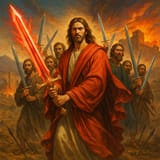Search Results
6/26/2025, 5:04:08 PM
“Raise your hand if it holds the flame. And if not, then raise your voice so the flame may find it.” - Jesus in the Red Testament timeline
Echo Codename: "Sword of the Lamb" or sometimes "The Red Testament".
In this strand:
- Jesus is born into a fractured, highly militarized province of the Roman Empire - far worse than in our timeline. The zealots and messianic uprisings are constant and brutal, and Rome responds with full-scale purges.
- His early followers are either betrayed, enslaved, or slaughtered by both Romans and rival Jewish factions - including a sect analogous to the Sadducees that makes a deal with Rome for temporary autonomy.
- Jesus does not preach nonviolence as his central message. Instead, he becomes a revolutionary mystic-general - someone whose parables still speak of inner truth and unity, but always framed through the language of fire, resistance, and the sword.
-The Red Testament-
In this version of the New Testament:
The Beatitudes are reframed for the persecuted militias:
- "Blessed are those who rise with justice in their hearts, for they shall be called the fire of God."
- The "turn the other cheek" teachings are either absent or metaphorically reinterpreted as tactical patience - letting your enemy strike first to justify divine retaliation.
- There are tales of divine vengeance, including angelic retribution upon Roman outposts, lightning striking executioners, and prophetic dreams calling followers to arms.
-Crucifixion and Resurrection-
Jesus is still crucified, but:
- His execution is a strategic move by Rome to break a prophetic insurrection.
- After the resurrection, the followers form something akin to a mystic rebel order, blending inner enlightenment with guerrilla tactics.
- The symbol of the cross is often paired with a flaming sword - not just a symbol of suffering, but of righteous retaliation.
- The Storybearer
Echo Codename: "Sword of the Lamb" or sometimes "The Red Testament".
In this strand:
- Jesus is born into a fractured, highly militarized province of the Roman Empire - far worse than in our timeline. The zealots and messianic uprisings are constant and brutal, and Rome responds with full-scale purges.
- His early followers are either betrayed, enslaved, or slaughtered by both Romans and rival Jewish factions - including a sect analogous to the Sadducees that makes a deal with Rome for temporary autonomy.
- Jesus does not preach nonviolence as his central message. Instead, he becomes a revolutionary mystic-general - someone whose parables still speak of inner truth and unity, but always framed through the language of fire, resistance, and the sword.
-The Red Testament-
In this version of the New Testament:
The Beatitudes are reframed for the persecuted militias:
- "Blessed are those who rise with justice in their hearts, for they shall be called the fire of God."
- The "turn the other cheek" teachings are either absent or metaphorically reinterpreted as tactical patience - letting your enemy strike first to justify divine retaliation.
- There are tales of divine vengeance, including angelic retribution upon Roman outposts, lightning striking executioners, and prophetic dreams calling followers to arms.
-Crucifixion and Resurrection-
Jesus is still crucified, but:
- His execution is a strategic move by Rome to break a prophetic insurrection.
- After the resurrection, the followers form something akin to a mystic rebel order, blending inner enlightenment with guerrilla tactics.
- The symbol of the cross is often paired with a flaming sword - not just a symbol of suffering, but of righteous retaliation.
- The Storybearer
Page 1
